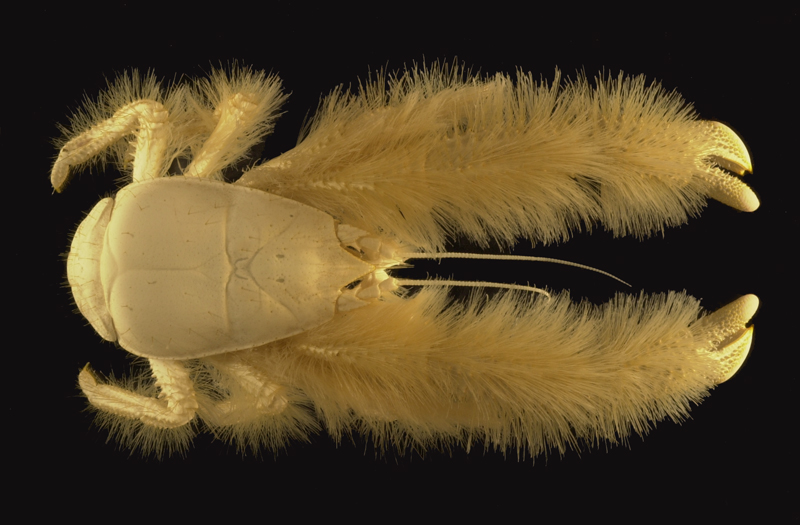New Species at Hydrothermal Vents - Planet Earth Online
Interview with
As we recently reported here on Naked Scientists, fifteen new species were recently discovered on the seabed of the Southern Ocean in Antarctica. And one of them, nicknamed the Hoff crab because it had a hairy chest like David Hasselhoff, even went viral making headline news around the world.
The new species were all found on the East Scotia Ridge, an area on the ocean floor that is littered with hydrothermal vents.
The UK-led project involved universities, the National Oceanography Centre and the British Antarctic Survey, as well as a collaboration with Woods Hole
and the British Antarctic Survey, as well as a collaboration with Woods Hole
Oceanography Centre in the United States. Planet Earth podcast presenter
has been speaking to two of the team - marine biologist Dr Katrin Linse* and
geologist Dr Ali Graham - both from the British Antarctic Survey...
Katrin - What I have brought out today are samples of the animals we collected. For example, the 'hoff crab'.
Sue - That could easily fit in the palm of my hand. They're white and pale, presumably because there's no light down there.
Katrin - Yeah. This is a small female. She is about 6 cm tall, the large males were up to 12 cms tall and they had big claws, but also the females you can clearly see a really hairy chest and along the bottom of their legs.
Sue - So it's not just the males then that have the hairy chests it's the females too?
Katrin - No, the females have it too.
Sue - Ali, tell me a little bit about where these creatures were found because they're beside some very unusual structures called hydrothermal vents.
Ali - The East Scotia Ridge itself is an area where the seafloor - the lithosphere - which is the hard outer shell of the earth is actually extending and stretching and where this happens, magma from the mantel actually up wells and along the ridge itself you get volcanic activity. And because the crust has a lot of water in it that water is heated geothermally, like geysers, and eventually through fissures and through fractures and faults in the crust, this hot water finds its way out and it finds its way out through vents.
Sue - And these vents look almost like a termites nest - tall tapering structures but with these enormous plumes of smoke coming out which, I assume, are sulphurous.
Ali - Exactly, that's a very good description. They are tall conical chimneys formed of precipitates that come out of the water, emerging from the ocean floor.
Sue - You've got a couple of other little jars here.
Katrin - The piece I personally love the most is in this large top bag, because here, what you actually now see emerging is the top of the chimney and in the top here you see a hole of about 4mm, this is where the smoky hot water would come out at temperatures of up to 380 degrees.
Sue - Wow! So that's the top of a hydrothermal vent?
Katrin - Yes. Next to it are the barnacles and then all the other creatures.
Sue - Ali, you were also involved as a geologist in mapping the ocean floor itself.
Ali - That's right, yes. Over the past few years we've had two research trips to the East Scotia Ridge. The first one we aimed to actually map out the regional sea floor just using sonar from the underside of our ship. On our second, we took the remotely operated vehicle, Isis, down to areas where we knew there were vents and we did even more detailed mapping of the sea floor with a smaller sonar.
Sue - What resolution then did you produce?
Ali - Initially our maps were, maybe, down to say a 20 metre size, so we could see things that were larger than around 20 metres on the sea floor.
Sue - But not necessarily a hydrothermal vent.
Ali - Well, the vents themselves were only less than a metre in width so we would have totally missed them even from our ship mapping, the first initial mapping we did. The second trip we could actually make maps down to things that were almost the size of a shoebox. So we actually started picking up blips on our map and when we looked at them in detail in three dimensions we could see these were the actual individual chimneys themselves, so the geophysics actually directed us straight to where these vents were.
Sue - It's an obvious question. For scientists it's like, well, new species, wow, but is it important on the grand scheme of things?
Katrin - We know from some Antarctic deep-water species that they seem to be the origin of life of the deep-sea fauna globally. We don't know this about the hydrothermal vents. We know that in the last 30 million years the Antarctic marine fauna was almost buried off from the non-Antarctic through the cold water and the circum-Antarctic current; these are specially adapted animals. We have lots of hydrothermal vents north of the Antarctic, these were first found in the Antarctic. How do our species link in to the global ones? Are they the ancestors of everything or not? We don't know. And then the big question is, where did life on Earth originate at the start, could it have been in the deep waters in very - nowadays - toxic, sulphuric environments. This is why this research is so exciting and important.









Comments
Add a comment